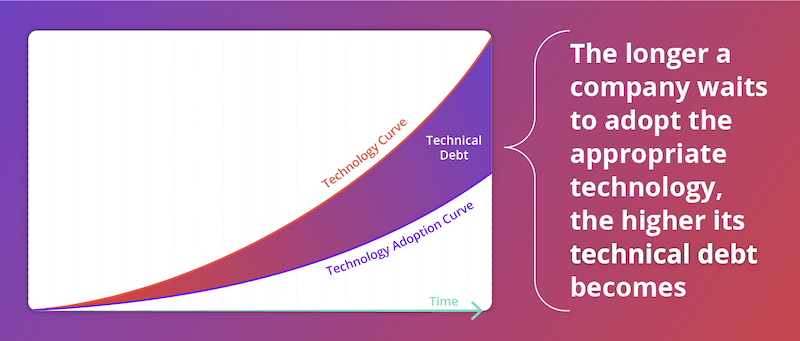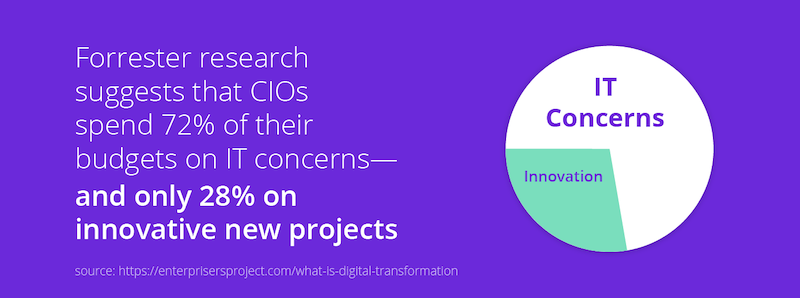CMS Debt Series: How the Wrong CMS Can Rack Up Insurmountable Technical Debt

In the first installment of our series on CMS debt, we talked about the high cost of replacing a poorly-chosen CMS.
In this segment, we’re going to explore the not-so-obvious technical debt that comes with continuing to try to make a poorly-chosen CMS work in your tech stack.
If your business is suffering from stunted growth, an inability to scale, squandered salary dollars and productivity hours, lost opportunities, failure to deliver on consumer expectations, and even a weak search engine presence—it could very well be the result of trying to force a square peg into a round hole when it comes to your CMS.
Here’s what you need to know about technical debt, how it can quietly ravage your company, and what you can do to nip it in the bud before it becomes downright impossible.
What is Technical Debt, and Where Does it Come From?
Technical debt is the sum of the money, flexibility, and opportunity lost when a company makes a poor technical investment or decision.
Businesses get into technical debt when time or budgetary constraints force CMOs and CTOs to choose the fastest or the most affordable solution instead of the best-fitting one with the most longevity. Often, this leads to the implementation of stand-alone pieces of technology that are simple enough to implement but that, over time, amount to a disjointed tech stack that only gets harder to secure, maintain, and update over time.

One of the most notable differences between technical and financial debt is that many companies are not monitoring and governing technical debt as they are financial debt.
This lack of attention makes it all the more likely that a business will get in over its head with insurmountable technical debt before they realize what’s happening.

While the monetary costs of technical debt aren’t typically tracked and are, therefore, hard to understand, it isn’t so hard to understand the damage it has on businesses when it comes to stunting growth, wasting productivity, and worse.
How Choosing the Wrong CMS Can Result in Technical Debt
Before we delve into the cost of choosing the wrong CMS, let’s quickly revisit what a CMS is and why it matters.
A content management system (CMS) is the platform most businesses use to create, distribute, and otherwise manage their content assets.
If you’re like many modern organizations, these content assets are the heart of the experience you create for consumers.
So, choosing a CMS that’s extremely expensive to maintain or incapable of being reconfigured to meet your growing business needs can understandably result in a large amount of technical debt, very quickly.
Stunted Business Growth and Scalability
It’s nearly impossible to predict what the future holds for your business but, hopefully, it’s growth.
That should be top of mind when you choose to implement any technology—and especially when you’re selecting your CMS.
Growth means more products or services, more content, more advertising channels, and more software and systems. To avoid getting into massive technical debt later, you’ll want to start from square one with a solid foundation for your tech stack—and the right CMS platform can be just that.
While a traditional, monolithic CMS will only be able to publish content to a website, a headless, API-first CMS decouples content from how it’s displayed and designed.
This decoupling allows IT, marketing, and design teams to work separately but in tandem to publish flawless content across channels at the speed of the consumer.
Plus, thanks to separating the content from the presentation layer, a headless CMS can serve as the base for an entire digital experience platform into which you can plug your ecommerce, marketing, data, personalization, and optimization tools to create a tech stack that scales up (or down) as needed.
Lost Salary Dollars, Productivity, and Opportunities
Do your systems keep getting harder to work with by the month? Are workers often spending more time wrangling resources, fixing bugs, or putting out fires than doing their actual jobs?
If so, you’re losing salary dollars and productivity that you can’t get back on developers and other personnel who are merely maintaining instead of moving your business forward.
And, if yours is one of the 90 percent of IT teams that report that the maintenance and expense associated with legacy systems prevent them from taking advantage of the technology their organizations need to grow—then you’re also missing out on significant business opportunities.
Putting a CMS at the center of your tech stack that’s expensive to maintain and too rigid to update is sure to rack up technical debt in the form of squandered productivity, salary dollars, and opportunities.

Weak Search Engine Presence
Just over half of all website traffic on the entire internet starts with organic search. Plus, over 40 percent of revenue is thought to be the result of organic traffic.
Search engine optimization (SEO) matters, and it all starts with creating and managing awesome content.
You want to choose a CMS that is thoughtfully designed to boost your SEO efforts at every turn. If it isn’t, you may notice your search engine presence is weak thanks to:
Poor Meta Tags
The search engine crawlers that “read” and help rank your website on search engine results pages rely on meta tags to learn what message each page is conveying. A CMS that doesn’t let your marketing team use relevant page titles, unique descriptions, and high-quality meta tags will prevent crawlers from finding and assigning a high ranking to your website pages.
Generic URLs
You want to be able to implement the keywords and phrases for which you want to rank in your page URLs. If your CMS doesn’t let you create your own keyword-rich URLs, you can say goodbye to highly-visible search results.
Inferior Code Base
While your website design may be the best on the planet, readers aren’t ever going to see it if the underlying code is bad!
Search engine crawlers can’t “see” your design. Instead, they rely on reading the code. If your CMS isn’t using search-engine-optimized code that these crawlers can understand, they’re not going to be able to prioritize your website over those with better code.
Getting the most SEO juice out of your content isn’t just about the content itself but the CMS you choose to use to host it. Start with a well-built and user-friendly CMS to keep yourself out of technical debt.
Inability to Keep Up with Consumer Expectations
By 2030, each person on the planet is expected to interact with as many as 15 different internet-enabled devices on a daily basis.
That’s great news considering that omnichannel shoppers tend to spend more. MasterCard found that consumers who shop both online and off buy 250 percent more than consumers who don’t. Macy's reports their omnichannel shoppers are eight times more valuable than their single-channel ones.
But this is not-so-great news for businesses who aren’t enabled with the technology needed to keep up, these omnichannel shoppers expect personalization at every touchpoint.
Nearly 80 percent of consumers will only engage with personalized offers, and 78 percent say relevant content makes them more likely to buy.
Whereas plain-text brand blogs were the status quo just a decade ago, today, consumer expectations are changing just as quickly as the technology that enables them.
You probably know where this is going. Working with a traditional CMS that forces you to publish the same general type of content to the same website day after day? That’s technical debt in the making.
But thanks to decoupling content from the presentation layer, a headless CMS enables businesses to create content once and redesign, reoptimize, and republish it as necessary.

Win “first-mover” advantage by being the fastest among your competitors to meet consumer expectations and secure your place as a market leader.
Prevent Racking Up Technical Debt by Choosing the Right CMS from the Start
There are tons of CMS options out there. What’s important is taking the time to choose the right one for your business.
To learn how to avoid racking up insurmountable technical debt by selecting the best-fit CMS from the very beginning, check out the do’s and don’ts in the first installment of this series on CMS debt: The High Cost of Choosing the Wrong CMS.
And to learn more about headless CMS itself and why it’s fast becoming the future of business and marketing, download our Ultimate Guide to CMS or see it in action for yourself—take Contentstack for a test drive today and see how seamlessly it can fit into your tech stack.
About Contentstack
The Contentstack team comprises highly skilled professionals specializing in product marketing, customer acquisition and retention, and digital marketing strategy. With extensive experience holding senior positions at renowned technology companies across Fortune 500, mid-size, and start-up sectors, our team offers impactful solutions based on diverse backgrounds and extensive industry knowledge.
Contentstack is on a mission to deliver the world’s best digital experiences through a fusion of cutting-edge content management, customer data, personalization, and AI technology. Iconic brands, such as AirFrance KLM, ASICS, Burberry, Mattel, Mitsubishi, and Walmart, depend on the platform to rise above the noise in today's crowded digital markets and gain their competitive edge.
In January 2025, Contentstack proudly secured its first-ever position as a Visionary in the 2025 Gartner® Magic Quadrant™ for Digital Experience Platforms (DXP). Further solidifying its prominent standing, Contentstack was recognized as a Leader in the Forrester Research, Inc. March 2025 report, “The Forrester Wave™: Content Management Systems (CMS), Q1 2025.” Contentstack was the only pure headless provider named as a Leader in the report, which evaluated 13 top CMS providers on 19 criteria for current offering and strategy.
Follow Contentstack on LinkedIn.







.svg?format=pjpg&auto=webp)
.svg?format=pjpg&auto=webp)
.png?format=pjpg&auto=webp)






.png?format=pjpg&auto=webp)


